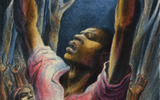
In 2011, the Georgetown University Library was awarded a $95,200 “Cataloging Hidden Special Collections and Archives” grant from The Andrew W. Mellon Foundation and the Council on Library and Information Resources (CLIR) to catalog the personal collections of six significant 20th-century American printmakers. We are proud to announce that this ground-breaking project is now complete.
The goal of Undiscovered Printmakers: Hidden Treasures in Georgetown University’s Library was to create online records of previously “undiscovered” items in the collection and make them available to the scholarly community. The six printmakers included in the project were renowned wood engravers and book illustrators, Lynd Ward (1905-1985) and John DePol (1913-2004), as well as four highly talented, but underappreciated, women printmakers of the same period: Louise Miller Boyer (1890-1976), Helen King Boyer (1919-2012), Marguerite Kumm (1902-1992), and Kathleen Spagnolo (b.1919).
More than 5,500 printmaking objects and ephemera were cataloged, with material ranging from preliminary sketches and drawings, trial proofs of prints, book mockups and finished prints, to the tools used to create them. Collection highlights include two complete sets of woodblocks for Lynd Ward’s pioneering graphic novels, Gods’ Man (1929) and Madman’s Drum (1930), as well as a bound book mockup of Madman’s Drum.
Other highlights include unique examples of John DePol’s distinctive wood engraved illustrations for the private press, some beautiful examples of Kathleen Spagnolo’s work in multi-viscosity printing and striking linocuts and aquatints by Marguerite Kumm. Project staff also discovered innovative examples of drypoints by Helen and Louise Boyer, who were pioneers in the use of aluminum printing plates for producing the drypoint printing technique. The catalog record for each object includes an image scan, and the records will all be searchable online within the next year.
The reorganization and cataloging of the collections has revealed exciting new details about the working methods of each artist, which will be of particular scholarly interest. Preliminary sketches and trial proofs have revealed the experimental processes undertaken by each artist that led to the final version of prints in each collection. Several of the collections, notably Ward’s and the Boyers’, are also complemented by substantial archives of correspondence and manuscripts which revealed personal insight into the context of the artists’ work.
An exhibition of highlights from the collections is being planned for next year.
